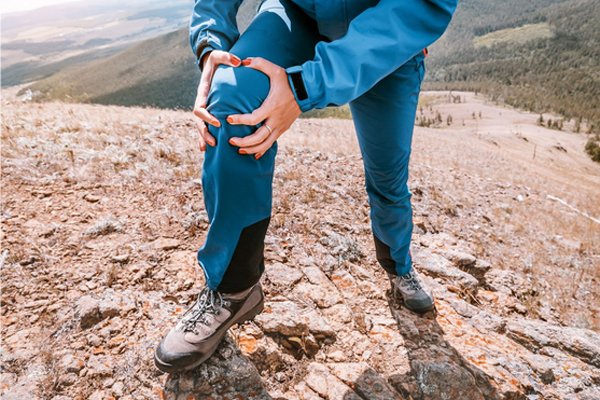In addition to being the largest joint in the body, your knee is also one of the more complex joints. With its complex structure, the knee is prone to injury, stress and pain. Today, we’ll investigate the inner workings of the knee joint and review some common conditions that affect this important joint.
The Anatomy of the Knee Joint
There are many parts and structures that make up the knee joint. By understanding the different structures and how they work together, we may better understand how knee conditions develop and what treatments may best address them.The Bones of the Knee Joint
Your knee is made up of three prominent bones: the femur (thighbone), the tibia (shinbone), and the patella (kneecap). The femur and the tibia meet at the knee joint to form a hinge joint, while the patella sits in front of the knee and helps protect the joint.
The Knee Ligaments
The knee ligaments are thick bands of tissue that connect to the bones and help stabilize the joint. Within the knee, there are four primary ligaments:
- The anterior cruciate ligament (ACL): This ligament is found in the center of the knee and prevents the tibia from sliding too far forward. An injury to the ACL is one of the most common knee injuries, particularly in athletes.
- The medial collateral ligament (MCL): Your MCL ligament is on the inner side of your knee and helps to stabilize the joint. It spans from the end of your femur to the top of your tibia.
- The posterior cruciate ligament (PCL): This ligament extends from the top-rear of the tibia to the bottom-front of the femur. The PCL helps prevent the knee joint from instability in the posterior of the knee.
- The lateral collateral ligament (LCL): The LCL connects the femur to the bones in your lower leg on the outer side of your knee. This ligament helps to stabilize the outer part of your knee.
Knee Cartilage
Your knee comes equipped with two types of cartilage, articular cartilage and meniscus cartilage. Articular cartilage is a type of smooth tissue that covers the ends of your femur and tibia, providing a low-friction surface for the bones to move on.The meniscus is a crescent-shaped piece of cartilage that acts as a shock absorber between the femur and tibia. The meniscus is tough and rubbery and helps distribute your body weight evenly across the knee joint.
Common Knee Conditions
Your knees are often under stress and pressure, so people often experience pain and other symptoms. Some of the most common knee conditions include:
Knee Ligament Injuries
Your knee ligaments are responsible for stabilizing your knee joint. When these ligaments are overstretched or torn, it may cause instability and pain within the joint. When dealing with a knee ligament injury, you may feel your knee starting to buckle or give out from under you. While anyone can injure their knee ligaments, athletes participating in high-impact sports are at a higher risk.Ligament tears often occur due to a sudden change in direction or trauma to the knee. Knee ligament injuries may be painful and require surgery to repair the damage. However, there are some instances where knee braces or other forms of support may be enough to stabilize the joint and allow for healing.
Torn Cartilage
Damage to the meniscus or articular cartilage is often referred to as a torn cartilage. This injury usually occurs due to wear and tear on the knee joint or from a traumatic event. The loss of cartilage may cause the bones to rub together, which leads to pain and inflammation.Symptoms of cartilage damage may include:
- Joint Pain
- Swelling
- Stiffness
- Grinding or clicking sensations
- The feeling of the knee giving out, locking, or catching
Because cartilage damage is often permanent, many individuals experiencing cartilage damage may need a partial or total joint replacement. There are also biologic treatments and regenerative medicine therapies that may be used to alleviate pain and preserve the knee until the patient is ready for a replacement.
Tendonitis
When the tendons in the knee become inflamed, it is referred to as tendonitis. Tendons are tough, fibrous tissues that connect muscle to bone. Knee tendonitis is often the result of overuse or repetitive motions. This condition is common in athletes or people who participate in activities that put stress on the knee, like jumping and running.Knee tendonitis may cause the following symptoms:
- Pain around the patellar tendon (the tendon that connects the kneecap to the tibia)
- Swelling
- Trouble bending and straightening the knee
- Tenderness behind the kneecap
Arthritis of the Knee
Osteoarthritis is among the most common types of arthritis in the knee. As we age, the cartilage in our joints begins to break down. This deterioration of cartilage leads to pain and inflammation as the bones begin to rub together. In addition, osteoarthritis may lead to bone spurs, which may cause even more pain.Rheumatoid arthritis is another commonly seen type of arthritis within the knee. This form of arthritis is caused by the immune system attacking the tissues in the knee joint. Rheumatoid arthritis often affects the joints symmetrically, meaning if one knee is affected, the other is likely to be as well.
Arthritis may also develop after an injury to the knee joint. This is referred to as post-traumatic arthritis and often affects people who have had a ligament tear or fracture. Treating arthritis may include a combination of medication, physical therapy and, in some cases, surgery.
Risk Factors for Knee Injuries
While knee injuries may occur without warning, there are risk factors that may increase your chances of developing a knee condition. Some of these risk factors include:
- Age
- Obesity
- Athletes who participate in high-impact sports
- Jobs that require repetitive kneeling or squatting
- Previous knee injuries
- A family history of knee problems
The best way to avoid knee injuries is to maintain a healthy weight, warm up before any physical activity, and avoid repetitive motions as much as possible. Lack of flexibility or muscle weakness may also contribute to knee injuries, so stretching regularly and strengthening the muscles around the knee joint is essential.


